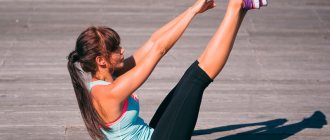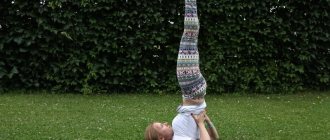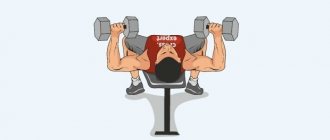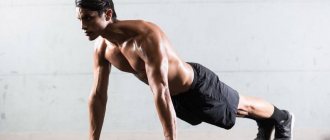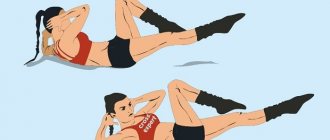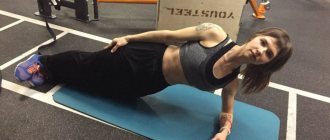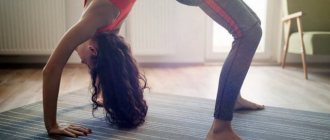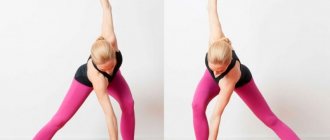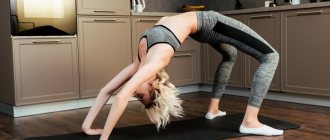The horizon exercise has another name: “planche”. This is one of the most spectacular and beautiful strength elements in a workout. In addition, this exercise also has great practical benefits. If you learn how to do a horizon, you will have the opportunity to perfectly pump your shoulders and many other muscles, since the peculiarity of this element is “polygamy” in the range of muscles involved.
In this article, our site will tell you about the horizon on the floor, but you can easily switch to the horizontal bar, parallel bars, and so on.
Since this element is classified at a more advanced level of complexity, in order to learn it, you need to go through a set of preparatory exercises.
How to learn to make a horizon
Push-ups with hands at the waist
Perform push-ups with your hands at your waist or with your weight shifted forward. If classic push-ups develop the triceps and chest muscles, then this exercise works the round muscles of the back and shoulder muscles. At first it will be difficult and uncomfortable for you, due to unfamiliarity, but this exercise is key, and in order to learn how to do the horizontal, you need to do push-ups in this way more than 20 times. If you do not have a muscular frame, then you need to be patient, since it may take a month or even more to achieve 20 push-ups.
Push-ups with legs against a wall
It is better to start this exercise after you have mastered push-ups with your hands at your waist.
The essence of the exercise is practically no different from the past; you also need to place your hands near your waist and your feet against the wall. But don't put your feet against the wall. When doing push-ups, they should slide along it and not be fixed. You may even sometimes feel that there is no wall at all. Some people advise wearing socks so that your feet can slide more easily and this will not interfere with your exercise. You also need to do push-ups against the wall more than 20 times. Don't be discouraged if you have problems at first.
Horizontal push-up with legs apart
Go ahead. Once you've learned how to do 20 reps with your feet against a wall, let's move on to push-ups without a wall. Take a horizontal stop. Hands, as always, are at waist level, and legs, without touching the floor, are spread as far apart as possible. The wider your feet are, the easier it is. So start by keeping your feet wide. This will help shift the center of gravity approximately to the waist and allow you to stand in this stance without using other points of support.
If there is not enough space around you, or it is difficult for you to spread your legs, then you can bend your knees, thereby also shifting the center of gravity towards the waist.
Gradually, it will become easier for you to do the exercises, then you should also gradually bring your legs together . Your main goal is to bring your legs together so that you are in a horizontal, full-length position.
Description
This exercise is borrowed from artistic gymnastics. Now it is actively used in the direction of street fitness workout.
The "horizon", or "planche" as it is often called, is an exercise in which the body is held horizontally with straight arms in a position parallel to the floor. The hands should be at the same level as the belt.
Many people wonder how to learn the “horizon” exercise on their own. This requires physical training and patience. A beginner should not try to perform the element right away; unprepared muscles and ligaments can be injured.
To learn, you need to acquire knowledge about the exercise and prepare physically. We'll talk about this below.
Advanced frog pose
For most trainees, advanced frog pose is a necessary intermediate step before successfully mastering the folded planche. At first, the supports in the frog pose are much easier than the bent planche, due to the fact that the support of the knees in half-bent arms allows you to support most of the body weight due to the knee-elbow ligament, and not due to the muscular strength of the shoulder girdle. In the subsequent bent planche, most of the load will be transferred directly to the shoulder girdle. For most non-gymnasts, the difference in load between the two exercises may be too great. Advanced frog pose can make this transition much easier. In it, the knees continue to be fixed on the arms, but the elbows straighten, moving the body into a position on straight arms. In this position, the amount of support your knees can provide is minimized because you are leaning into straight arms rather than supporting yourself with bent elbows. In addition, using a complicated frog pose will allow you to more gradually increase the intensity of the load on the shoulder girdle. It is important to emphasize maintaining a completely straight arm position when performing advanced frog pose. By allowing your elbows to bend, you take the load off the shoulder girdle and elbow joint, where it must be applied in order for there to be progress in the development of the planche.
- Hold in a difficult frog pose for 1 minute.
- Do push-ups from the floor in a complicated frog pose 40 times.
- Stand on two hands in the Frog Pose position. Near the wall.
- Stand on two hands in the Frog Pose position. Without a wall.
Safety precautions
To minimize the risk of injury, inversion lifting on the horizontal bar must be performed in compliance with the safety rules:
- Use arm straps during training. This will prevent you from falling if you accidentally slip.
- If the exercise is performed for the first time, it is recommended to ask someone for backup. It should be on the side of the swing leg. If necessary, the belayer pushes the trainee's hips, holding him by the forearms.
- Make every movement smoothly, without jerking. This will reduce the risk of dislocations and sprains.
- Try to avoid rocking. It is only permissible when the movement is performed 1-2 times.
- Select the horizontal bar at the optimal height. The athlete must not touch the ground with his feet.
- If necessary, use liquid or climbing magnesium. This will help prevent those with very sweaty hands from slipping off the bar.
You shouldn’t perform hanging leg raises on the bar if you can’t even just do pull-ups at least 10 times.
Secrets to the Effectiveness of Hanging Leg Raises
Knowing them allows you to conduct training with 100% efficiency:
- do not use inertial forces;
- perform lifts cleanly, without rocking your body;
- lingering for a couple of counts at the end point, additionally tighten your abdominal muscles;
- if you have a lot of weight, use parallel bars equipped with a backrest;
- if the grip is weak, i.e. hands “unhook” on the bar, use belts and straps for your hands;
- For beginners, the same parallel bars and wall bars can serve as an option. To make lifting easier, you can lift with bent legs;
- for “advanced” athletes, weights are needed, which are dumbbells and weights attached between the feet;
- in the classics you need to raise your legs 90 degrees, but beginners can reduce the angle;
- It is recommended to do 10-15 repetitions and 2-3 approaches.
What muscles work
Although the exercise is static, when performing it, most of the muscles and muscle groups of our body are involved:
Read also: The dog is afraid to ride in the car
- Deltoid, first, frontal;
- round muscles of the back (minor and major);
- abdominal Press;
- spinal extensor muscles;
- body stabilizer muscles;
- chest muscles;
- triceps.
A certain load also falls on the muscles of the thighs and buttocks, which keep the legs straight.
For workout athletes, a horizontal position with emphasis on the floor is absolutely necessary, because it promotes the development of the extensor muscles of the body and deltoids, which is difficult to achieve without strength exercises in the gym. In addition, it helps improve coordination of movements, as well as a sense of equilibrium and balance.
Benefits, harms, contraindications
Like any other sports element, the horizontal exercise on the horizontal bar has its advantages and disadvantages.
As positive points it is worth noting:
- additional shoulder relief;
- increase in deltas and triceps;
- strengthening the abs and torso;
- Thanks to the powerful static load, visceral fat is actively burned.
The only disadvantages include insufficient physical training, due to which you can get injured while performing the exercise.
Contraindications to performing the element are:
- joint injuries of the hands (shoulder, wrist or elbow);
- dislocations;
- weak fingers;
- spinal hernia or injury;
- protrusion.
Training option
The second training option can be used if you are really impatient. In general, if you don't really need a front hang on the tunic, then you can use the first option. Using the first option, you will learn how to perform not only a horizontal front hang, but also a two-handed approach with a narrow grip. In the second option, you will need to hang in a tuck position with both legs bent at the knees. Once you are confidently hanging in a tuck position with both legs bent, you can gradually begin to straighten your legs. We hang and straighten one leg at a time, but this needs to be done quickly, at first. Afterwards, you can try to straighten both legs at once, which is much more difficult. If I were to teach a horizontal front hang this way, I would immediately try to straighten both legs. As an option, you can raise your legs as if you want to do an inversion lift, but without completing the exercise, lower your legs and at the same time straighten up.
Horizon with emphasis on the floor: detailed technique
Street workout is one of the youngest sports and is considered a “street sport”, where the horizontal bar and parallel bars are used as the main exercise equipment.
However, the basis for numerous workout tricks are classical gymnastic exercises, in particular the horizontal on the floor, or planche, which gives an excellent effect for building muscle strength. Despite its apparent simplicity, it requires a lot of physical effort.
This static strength exercise serves as excellent preparation for performing a horizontal bar and on the uneven bars, so let’s take a closer look at how to do a horizontal horizontal with an emphasis on the floor correctly.
Numerous photos and videos on the Internet give an idea of this, and there is also a tutorial there that shows in detail, with all the nuances, how to learn to keep the horizon.
Execution of the “frog” and variations
How to learn to make a horizon correctly? It is recommended to practice more and do exercises to develop the muscles of the arms and body. One of them is called "frog". To perform, you need to squat down and rest on the floor in front of your feet. The knees are spread as far apart as possible, the weight is transferred to the hands, into which the knees rest and gradually rise. The body is supported only by the arms.
The execution option helps not only to increase the endurance of the arm muscles, but also helps to keep the body in the desired balance, albeit with high tension. If you rest your knees on your elbows and squeeze your triceps, you will create additional stress. This is one of the techniques that tells how to learn how to make a horizon on the floor, as it helps to train the arm muscles.
How to prepare your body for pull-ups?
If you have never done a pull-up, first prepare the central nervous system, ligaments, muscles and tendons for the load. Start by hanging loosely on the bar, trying to hold on until your fingers give out. It is important to have a strong grip.
Strengthen your arm and chest muscles with push-ups. If you can’t do this exercise 10-15 times, then it’s too early to think about pull-ups. Develop the habit of breathing correctly during exercise. Oxygen saturation of the muscles depends on breathing. Lack of air reduces muscle efficiency. And if you understand that excess weight is preventing you from learning how to do pull-ups, then it’s time to think about losing a few extra pounds.
Will hanging leg raises help you get six-pack abs?
This training is generally considered to have a “drying” effect, i.e. By performing 50 hanging leg raises or more, you can remove belly fat and see your treasured abs. But, it is important to understand that not a single abdominal exercise has any effect on fat accumulated in the abdominal area. They only help strengthen muscle tissue. Therefore, neither an insane number of repetitions nor a burning sensation will appear in the abs.
Without diet - the main developer of cubes, even existing abs, but hidden under a layer of fat, cannot be seen. It will remain a “nasty” ball.
Training Tips
Even with examples of training before your eyes, you may not take into account some of the subtleties.
Warm-up and stretching
I recommend that you do a good warm-up before training and stretching after. Remember, warming up is the basis that will protect you from injury. Carefully work out all the joints, for the horizon, emphasis on the shoulders, elbows and wrists. You can work them out by jumping, and at the same time there will be a cardio load. After completing each exercise, do not sit between approaches, but warm up those muscles that were not worked. After completing all sets of the exercise, slightly stretch the muscles that were loaded.
Sets and reps
In push-ups, you need to achieve 20 repetitions of 3 to 4 sets. With dumbbells 3 – 4 sets of 30-40 repetitions. With a barbell, 2-3 sets of 7-8 repetitions are enough. Elements should be held static for as long as possible, ideally 10 seconds without shaking. Distribute the load in stages from simple to complex. After completing each element, do a cool-down or stretch the muscle that was loaded.
Front hang on the horizontal bar
The front hang is one of the most difficult, but also effective exercises with your own body weight. It is performed as holding your body in a lying position while hanging on a sports apparatus. From the outside it looks like you are holding yourself up in the air.
The front hang on the horizontal bar can be performed in a stationary position, or in dynamic repetitions. There are several types of exercises, varying in complexity and level of training.
Muscles involved in the "horizon"
As mentioned above, horizontal is a static exercise, and when performing it, almost all the muscles of the human body are involved. The main load falls on the following muscle groups:
- anterior bundles of deltoid muscles (shoulders);
- triceps muscle (triceps);
- pectoral muscles;
- abdominal muscles;
- large and small muscles of the back;
- spinal extensor muscles;
- trunk stabilizer muscles.
The leg muscles (gluteus and thigh muscles) that keep the legs straight are also stressed.
Both in the usual static horizontal and in performing push-ups in the horizontal, all muscles are involved. Therefore, you need to thoroughly prepare your body for future stress. Leading exercises will help us with this.
